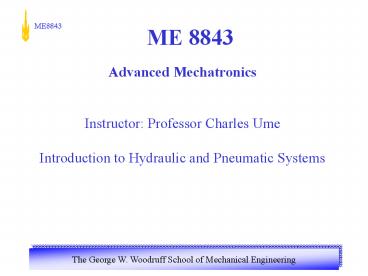ME 8843 - PowerPoint PPT Presentation
1 / 23
Title:
ME 8843
Description:
ME 8843 Advanced Mechatronics Instructor: Professor Charles Ume Introduction to Hydraulic and Pneumatic Systems Outline Introduction Hydraulic system Pneumatic system ... – PowerPoint PPT presentation
Number of Views:64
Avg rating:3.0/5.0
Title: ME 8843
1
ME 8843
- Advanced Mechatronics
- Instructor Professor Charles Ume
- Introduction to Hydraulic and Pneumatic Systems
2
Outline
- Introduction
- Hydraulic system
- Pneumatic system
- Key components
- Valves
- Actuators
- Examples
3
Hydraulic/Pneumatic Systems
- Use fluids as working media
- Convert electrical/mechanical energy into
potential energy of fluids (pump, compressor) - Transmit power through distribution lines (pipes,
air hoses) - Convert potential energy of fluids/compressed gas
into mechanical energy that turns linear/rotary
actuators
4
Applications
Air Conveyor
Impact Wrench
Hydraulic Jack
- Advantages
- adaptable power distribution
- constant force actuators
- power amplification
- inexpensive
- Disadvantages
- difficult to control position
- leaks and contamination of working fluid
5
Pascals Law
- Pascal's law states that "a change in the
pressure of an enclosed incompressible fluid is
conveyed undiminished to every part of the fluid
and to the surfaces of its container. - Force determined by pressure
- Speed determined by flow rate
6
Hydraulic Systems
- Move large loads by controlling high-pressure
fluid in distribution lines and pistons with
mechanical or electromechanical valves - 1000psi 3000psi
- Closed systems, always recirculating same fluid
7
Hydraulic Systems
- Advantage
- Able to generate extremely large forces from
compact actuators - Easy to control speed
- Easy to implement linear motion
- Disadvantage
- Large infrastructure (high-pressure pump, tank,
distribution lines) - Potential fluid leaks
- Noisy operation
- Vibration
- Maintenance requirements, expensive
- Characteristics of working fluids change with
temperature and moisture
8
Pneumatic systems
- Pneumatic systems similar to hydraulic systems
- Use compressed air as working fluid rather than
hydraulic liquid - 70psi - 150psi, much lower than hydraulic system
pressures, much lower forces than hydraulic
actuators - Energy can be stored in high pressure tanks
- Open systems, always processing new air
9
Pneumatic systems
- Advantage
- Constant force
- Clean (food industry)
- No return lines needed
- Adaptable infrastructure
- Possible light, mobile pneumatic systems
- Fast system response
- Disadvantage
- Difficult to achieve position control
(compressible air) - Noisy
10
Key components of Hydraulic and Pneumatic
- Pump/Compressor
- Pressure regulator
- Valve
- Actuator
11
Valves
- Infinite position valve as shown in figure on
right - allows any position between open and closed to
modulate flow or pressure - Finite position valve
- has discrete positions, usually just open and
closed, providing different pressure and flow
condition - Ports inlet and outlet connections to valve
- Finite position valve usually specified as x/y
valve - x number of ports (sum of inlets and outlets)
- y number of positions
- 4/3 valve 4 ports and 3 positions
Pressure regulator
12
Types of Valves
- Type Spool, poppet, ball, butterfly valves, etc.
Poppet valve
Spool valve
Check valve (One directional flow)
Ball valve
Butterfly valve
13
Valve symbols
Position with texts indicates initial position
Valve connections
Valves with controls indicated
14
4 ports/3 positions Solenoid Spool Valve
15
Example Pneumatic lift system (analogous to car
jack)
Lift load
Lower load
16
Hydraulic/Pneumatic actuators
- Cylinders with piston driven by pressurized fluid
- Single acting cylinder (SAC)
- Double acting cylinder (DAC)
- Two well-defined endpoints
- Rotary
17
Key parameters in choosing air cylinders
- Stroke length
- Bore size
- Pressure rating
- Mounting style
- Return type (SAC vs. DAC)
- Spring force in SAC
- Loads
- Temperature range
- Lubrication
- Material Compatibility
Force
18
Example 1 LEGO house builder
- Weight
- Stroke
- Speed
- Force
- Accurate positioning not required
Lead Screw
Pneumatic
19
Example 2 Anti-Lock Braking System
- Regular Automobile Breaking System Includes
- Hydraulic actuation
- Pneumatic power assist
- ABS includes additional features
- sensors
- valves
- hydraulic pump
- control unit
20
Hydraulic System
fluid reservoir
Supplies the main braking force to the pistons at
the wheels
actuated by brake pedal
Front circuit
Rear circuit
- Proportioning Valves control the pressure
provided to the front and rear - Can change pressure distribution according to
vehicle weight distribution - Metering Valves- engage the rear breaks before
the front
21
Pneumatic Power Assist
Brake Applied
Brake Released
Vacuum from engine
Bi-directional check valve
- Brakes applied
- Opens check valve to pressurize one side of
diaphragm - Pressure difference assist in applying braking
force - Pushes pistons in master cylinder
- Brakes released
- Check valve closes and engine vacuum is again
applied to both chambers
22
Anti-lock Breaking System
- Wheel speed sensor
- Electric hydraulic pump
- Stores fluid in pressurized chamber
- Solenoid valves
- Open braking pressure supplied directly from
master cylinder (under normal conditions) - Closed isolate master cylinder pressure line
(modulation) - Release applies stored pressure to blocked break
lines (modulation)
23
Reference
- Mechatronics, by Sabri Cetinkunt, published by
Wiley - Introduction to Mechatronics and Measurement
Systems, Second Edition, by David G. Alciatore
and Michael B. Histand - Mechatronics Electronic Control Systems in
Mechanical Engineering, by W. Bolton - http//en.wikipedia.org/wiki/Pascal27s_law
- http//en.wikipedia.org/wiki/Pneumatic_cylinder
- http//www.bimba.com
- http//www.tpub.com/content/engine/14105































